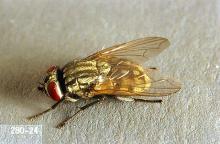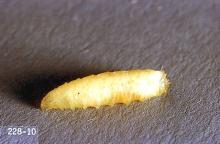Musca autumnalis
Biology Face flies feed on the secretions of the eyes and nose for short periods of time. The adult face fly is 6 to 10 mm long and grey with brown stripes in appearance. Only a small percentage of the local face fly population may be found on animals at any one time. These aspects of its life history make management of face fly a very difficult task. Hence, many of the products labeled for efficacious horn fly control indicate that they merely aid in face fly control.
Management-chemical control
Ear tags, strips
- abamectin/piperonyl butoxide ear tag (XP 820)-Apply one tag to each ear when flies become a problem, to reduce face flies. Remove tags at end of fly season or before slaughter.
- beta-cyfluthrin/piperonyl butoxide ear tag (CyLence Ultra)-Apply one tag to each ear of all animals older than 3 months when flies appear. Remove tags at end of fly season or before slaughter.
- permethrin ear tag (GardStar Plus)-Apply one tag per ear on all animals when flies first appear in spring. Remove before slaughter.
- zeta-cypermethrin/piperonyl butoxide ear tag (PYthon; PYthon II; PYthon MagnuM)-Apply one tag per head of all animals at least 3 months old when flies appear in spring. Controls for 3 to 4 months. Remove tag at the end of fly season or before slaughter.
- zeta-cypermethrin/abamectin/piperonyl butoxide ear tag (Tri-Zap)-Apply one tag per ear of all animals. Remove at end of season or before slaughter.
Pour-ons, sprays
- coumaphos (Co-Ral Fly & Tick Spray)-Mix 1 quart per 50 gal water. Spray to complete wetting to run-off. Do not apply more than 1 quart per 50 gal water to non-lactating dairy cattle within 14 days of freshening. Treat no more than 6 times/year. Do not apply less than 10 days apart.
- cyfluthrin pour-on (CyLence)-Rates are dependent on weight. See label for dosing instructions. Pour along top of back and head of cattle of all ages. Repeat as needed but no more than once every 3 weeks.
- dichlorvos spray, concentrate (Vapona [40.2%]; Nuvan Fog2EC [25%], Fog4EC [41.4%], Fog5%;)-Dilute to 1% solution (follow label directions) and apply 1 to 2 fl oz of solution per animal (per day) as a fine mist spray. Do not wet hide. Do not treat calves under 6 months of age. Do not apply within 1 day of slaughter.
- dichlorvos spray, ready-to-use (Prozap Beef & Dairy RTU)-Apply 1 to 2 oz per adult animal as a mist to wet hair. Use proportionately lower rates for smaller animals. Do not exceed 2 oz per animal per day. Do not soak skin or wet hide.
- dichlorvos/piperonyl butoxide/pyrethrins (Prozap VIP Insect Spray)-Apply 1 to 2 oz to each animal, proportional to size. Do not soak the skin or wet the hide. Do not apply more than once per day.
- permethrin spray, ready-to-use (various manufacturers; 0.25%-1%)- Spray animal as directed.
- permethrin spray, concentrate (various manufacturers; 10%-40%)-Dilute in water as directed. Spray animal as directed. Typical application interval is 14 days, as needed, but follow label.
- permethrin pour-on (various manufacturers; 1%-10%)-Apply to animal as directed. Typical application interval is 14 days, as needed, but follow label.
- permethrin/piperonyl butoxide spray, ready-to-use (various manufacturers; 1%)-Apply to animal as directed. Typical application interval is 14 days, as needed, but follow label.
- permethrin/piperonyl butoxide spray, concentrate (various manufacturers; 10%)-Dilute in water as directed. Spray animal as directed. Typical application interval is 14 days, as needed, but follow label.
- permethrin/piperonyl butoxide pour-on (various manufacturers; 0.125%-10%)-Apply to animal as directed. Typical application interval is 14 days, as needed, but follow label.
- pyrethrins spray (PyGanic Livestock & Poultry Insecticide; PyGanic Specialty)-Dilute as directed. Apply using large-droplet spray to face of animal in morning. Do not exceed 1.5 oz of diluted solution per animal or 1 treatment per day. This organic product is OMRI listed.
- pyrethrins spray (Tersus 5%)-Dilute in water as directed. Spray with large droplets avoiding eyes or wet cloth and wipe face. Do not apply more than once per day.
- pyrethrins/piperonyl butoxide spray, ready-to-use (various manufacturers; 0.1%-0.5%)-Apply to cloth and wipe on face.
- pyrethrins/piperonyl butoxide spray, concentrate (various manufacturers; 0.96%-6%)-Dilute in water or oil as directed. Apply to cloth and wipe on face.
- pyrethrins/permethrin/piperonyl butoxide spray (Raze) -Spray face and head but do not spray into eyes. Repeat treatment when flies are troublesome.
- pyrethrins/piperonyl butoxide/N-octyl bicycloheptene dicarboximide spray (SSI-50)-Spray entire animal from two-foot distance as it's being released to pasture.
- soybean oil/peppermint oil/cinnamon oil/lemongrass oil/garlic oil (Purely Green Bio-Pesticide Super Concentrate)-Dilute product at 1 to 2 fl oz per gal water.
Backrubbers (oil)
- coumaphos (Co-Ral Fly & Tick Spray)-Mix 4 quarts in 13 gal fuel oil to coat backrubber. Suspend at a height that dairy cattle won't straddle. Do not use diesel or home furnace oil (fuel oil). Resaturate as needed.
- permethrin (various manufacturers; 1%-40%)-Use undiluted or dilute in oil as directed. Recharge as needed.
- permethrin/piperonyl butoxide (various manufacturers; 0.125%-10%)-Use undiluted or dilute in oil as directed. Recharge as needed.
- tetrachlorvinphos/dichlorvos (Ravap EC)-Mix 1 gal in 25 gal approved oil and use in mechanical rubbing device or burlap or rope backrubber. Recharge as needed.
Dusts
- coumaphos dust (Co-Ral 1%)-Place bags so they hang 4 to 6 inches below animals' backline. Direct applications of 2 oz per animal may be repeated no more frequently than 10 days apart and no more than 12 applications in 12 months.
- permethrin dust (various manufacturers; 0.25%)- Place bags so they hang 4 to 6 inches below animals' backline. Direct applications of 2 oz per animal may be repeated as needed but no more than once every 3 days.
- zeta-cypermethrin/piperonyl butoxide dust (PYthon Dust; PYthon II Dust)-Apply in dust bag, shaker, dusting glove, or mechanical duster. Place bags so they hang 4 to 6 inches below animals' backline. Direct applications of 2 oz per animal may be repeated as needed but not more often than once every 3 days. Do not use concurrently with insecticide ear tags containing zeta-cypermethrin or cypermethrin.
Feed supplements (prevent development of flies in the manure of treated cattle)
- diflubenzuron feed supplement (ClariFly 0.04%; ClariFly 0.67%; ClariFly 8%; JustiFly 3%)- Mix into grain according to label to provide 0.1 mg ai/kg (4.55 mg/100 lb) body weight per day (follow table on label). Start feeding early in spring before flies appear and discontinue when cold weather limits fly activity.
- diflubenzuron mineral tub (Vitalix ClariFly #5 Tub)-Provide free choice with targeted consumption of 1.6 ounces per 100 lb of cow per day (~one tub per 15-25 head). Provide before flies appear until end of fly season.
- tetrachlorvinphos feed supplement (Rabon 7.76)-Include in diet or supplement at 70 mg per 100 lb body weight daily. See Mixing Guide for additional details.



